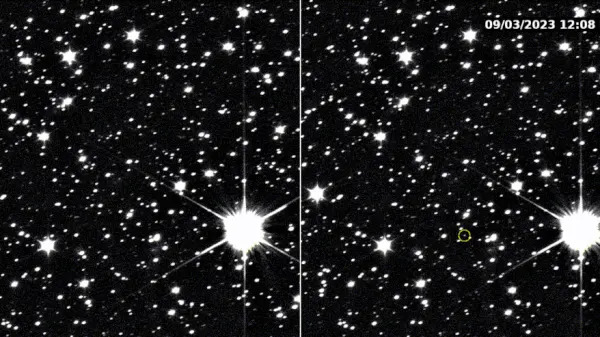Sharmila Kuthunur
Wed, September 13, 2023

An animation showing two black and white images side-by-side. The right image has a yellow circle around the dot that is moving across the screen in both images.
NASA's Lucy spacecraft just sent home an impressive glimpse of the smallest asteroid target on its 12-year agenda to study intriguing space rocks.
Asteroid Dinkinesh, a mere 0.5 mile-wide (1 kilometer-wide) rock residing in the inner part of the main asteroid belt between Mars and Jupiter, was captured by one of Lucy's high resolution cameras from a whopping 14 million miles (23 million km) away.
The images, snapped on Sept. 2 and Sept. 5, feature Dinkinesh as a speck of light nearly lost amid countless similar spots if not for NASA circling it in the photos to aid the eye.
"This is really a tiny little asteroid," Hal Levison, the principal investigator for the Lucy mission, had said in a statement earlier this year. "Some of the team affectionately refer to it as 'Dinky.' But, for a small asteroid, we expect it to be a big help for the Lucy mission."
Launched in October 2021, the Lucy spacecraft is scheduled to visit the Trojan asteroids, a cloud of space rocks located between the orbits of Mars and Jupiter. These shards are considered remnants of our ancient solar system from over four billion years ago. Dinkinesh, however, was added to Lucy's agenda as a risk-mitigation exercise to test the efficiency of the spacecraft's tracking system — specifically whether it could hold the rock in its field of view while gliding closer at speeds of 10,000 miles per hour (4.5 kilometers per second).
"Dinkinesh will remain an unresolved point of light during the long approach and won't start to show surface detail until the day of the encounter," NASA representatives said in a statement.
Over the next couple of months, an optical navigation program onboard Lucy will track Dinkinesh's position with respect to a star-studded sky to guide the spacecraft for an accurate flyby. Finally, on Nov. 1, Lucy will be just 265 miles (425 km) from the space rock, scientists say.
The flyby on Nov. 1 will also be useful in assessing the accuracy with which Lucy can point at a target, as one of the spacecraft's two solar arrays did not properly unfurl after its 2021 launch. Late last year, the mission team estimated the array to be 98% deployed and suspended further efforts, noting it "carries an acceptable level of risk."
"We're not exactly sure, given that the solar array is not latched, of the pointing stability characteristics of the spacecraft, so this will also help us determine that," Levinson said earlier this year at a meeting about announcing Dinkinesh, according to SpaceNews.
The name Dinkinesh translates to "you are marvelous" in Amharic — an official language in Ethiopia, where the 3.2 million-year-old fossils of an early female ancestor nicknamed "Lucy" were discovered in 1974. Similar to those fossils shedding light on human evolution, scientists think the Lucy spacecraft will illuminate early solar system history.
No comments:
Post a Comment